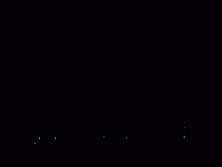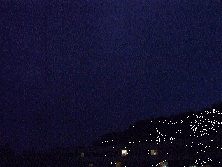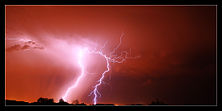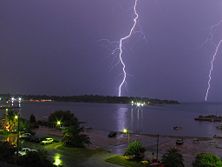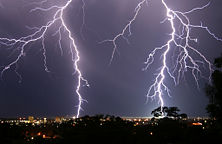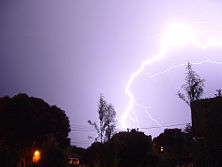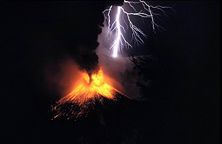Lightning
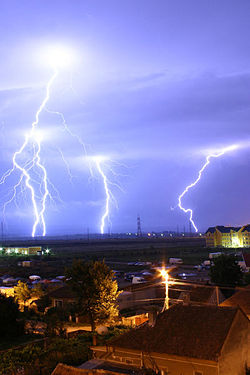

Lightning is an atmospheric discharge of electricity, which typically occurs during thunderstorms, and sometimes during volcanic eruptions or dust storms.
History of research
Beginnings
In his Dream Pool Essays of 1088 C.E., the Song Dynasty polymath Chinese scientist Shen Kuo (1031-1095) wrote of the natural phenomenon of lightning. When a house belonging to one Li Shunju had been struck by lightning, Kuo wrote that everyone assumed that the house would be burnt to the ground. To everyone's surprise, some of the wooden walls were merely blackened and lacquerwares untouched, while metal objects such as a steel sword were melted into liquid.[1] Kuo compared this phenomena to the equally strange effects of water being unable to douse Greek fire (which had been known to the Chinese since the Arabs had traded it, or a chemical composition fairly equal to it, in the tenth century).[1][2] For these strange effects of lightning, Kuo wrote:
Most people can only judge of things by the experiences of ordinary life, but phenomena outside the scope of this are really quite numerous. How insecure it is to investigate natural principles using only the light of common knowledge, and subjective ideas.[1]
Thus was the frustration of learned men in his time of the desire to know the true nature of lightning and other such common phenomena. However, in the Western world the true nature and understanding behind its force would become known by the eighteenth century.
Benjamin Franklin (1706-1790) endeavored to test the theory that sparks shared some similarity with lightning using a spire which was being erected in Philadelphia. While waiting for completion of the spire, he got the idea of using a flying object, such as a kite, instead. During the next thunderstorm, which occurred in June 1752, it was reported that he raised a kite, accompanied by his son as an assistant. On his end of the string he attached a key and tied it to a post with a silk thread. As time passed, Franklin noticed the loose fibres on the string stretching out; he then brought his hand close to the key and a spark jumped the gap. The rain which had fallen during the storm had soaked the line and made it conductive.
Franklin was not the first to perform the kite experiment. Thomas-François Dalibard and De Lors conducted it at Marly-la-Ville [3] in France a few weeks before Franklin's experiment. In his autobiography (written 1771-1788, first published 1790), Franklin clearly states that he performed this experiment after those in France, which occurred weeks before his own experiment, without his prior knowledge as of 1752. According to author Tom Tucker, Franklin never actually performed the famed kite experiment, but rather published his account of it as a hoax, possibly to endanger his detractors.[4]
Continuing research
As news of the experiment and its particulars spread, people attempted to replicate it. However, experiments involving lightning are always risky and frequently fatal. The most well-known death during the spate of Franklin imitators was that of Professor George Richmann, of Saint Petersburg, Russia. He had created a set-up similar to Franklin's, and was attending a meeting of the Academy of Sciences when he heard thunder. He ran home with his engraver to capture the event for posterity. While the experiment was under way, ball lightning appeared, collided with Richmann's head and killed him, leaving a red spot. His shoes were blown open, parts of his clothes singed, the engraver knocked out, the door frame of the room split, and the door itself torn off its hinges.
Although experiments from the time of Franklin showed that lightning was a discharge of static electricity, there was little improvement in theoretical understanding of lightning (in particular how it was generated) for more than 150 years. The impetus for new research came from the field of power engineering: as power transmission lines came into service, engineers needed to know much more about lightning in order to adequately protect lines and equipment.
Properties of lightning
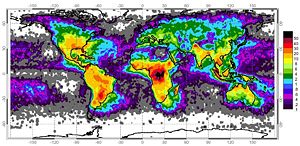
A bolt of lightning can travel at a speed of 45 km/s (kilometers per second) (100,000 mph, 160,000 km/h).[5] It can reach temperatures approaching 28,000 °C (50,000 °F), hot enough to fuse soil or sand into glass channels.[6]
An average bolt of negative lightning carries an electric current of 40 kA (kiloamperes), although some bolts can be up to 120 kA, and transfers a charge of 5 coulombs and 500 MJ (megajoules), or enough energy to power a 100 watt lightbulb for just under two months. The voltage depends on the length of the bolt: with the dielectric breakdown of air being 3 million volts per meter, this works out at about one billion volts for a 300m (1,000 feet) lightning bolt.
Different locations have different potentials (voltages) and currents for an average lightning strike. For example, Florida, with the United States' largest number of recorded strikes in a given period during the summer season, has very sandy ground in some areas and conductive saturated mucky soil in others. As much of Florida lies on a peninsula, there is a daily development of sea and lake breeze boundaries that collide and produce thunderstorms. Arizona, which has very dry, sandy soil and very dry air, has cloud bases as high as 6,000-7,000 feet above ground level, and gets very long and thin purplish discharges that crackle. Oklahoma, with cloud bases about 1,500-2,000 feet above ground level and fairly soft, clay-rich soil, has big, blue-white explosive lightning strikes that are very hot (high current) and cause sudden, explosive noise when the discharge comes. The difference in each case may consist of differences in voltage levels between the clouds and the ground.
NASA scientists have also found that the radio waves created by lightning clear a safe zone in the radiation belt surrounding the earth. This zone, known as the Van Allen Belt slot, can potentially be a safe haven for satellites, offering them protection from the Sun's radiation.[7] [8][9]
The first process in the generation of lightning is still a matter of debate.[10] Scientists have studied root causes ranging from atmospheric perturbations (wind, humidity, and atmospheric pressure), to the impact of solar wind and accumulation of charged solar particles.[11] Large quantities of ice in the clouds are suspected to enhance lightning development.[11] This charge will neutralize itself through any available path. This may assist in the forcible separation of positive and negative charge carriers within a cloud or air, and thus help in the formation of lightning.
Lightning can also occur within the ash clouds from volcanic eruptions,[12][13] or can be caused by violent forest fires which generate sufficient dust to create a static charge.
Formation
- Note: Positive lightning, a rarer form of lightning that originates from positively charged regions of the thundercloud, does not generally fit the pattern discussed below.
Charge separation
The first process in the generation of lightning is charge separation.
Polarization mechanism theory
The mechanism by which charge separation takes place is still a subject of research, but one theory is the polarization mechanism, which has two components:[14]
- Falling droplets of ice and rain become electrically polarized as they fall through the atmosphere's natural electric field.
- Colliding ice particles become charged by electrostatic induction.
Electrostatic induction theory
Another theory is that opposite charges are driven apart by the above mechanism and energy is stored in the electric field between them. Cloud electrification appears to require strong updrafts, which carry water droplets upward, supercooling them to -10 to -20 °C. These collide with ice crystals to form a soft, ice-water mixture called graupel. The collisions result in a slight positive charge being transferred to ice crystals, and a slight negative charge to the graupel. Updrafts drive lighter ice crystals upwards, causing the cloud top to accumulate increasing positive charge. The heavier negatively charged graupel falls towards the middle and lower portions of the cloud, building up an increasing negative charge. Charge separation and accumulation continue until the electrical potential becomes sufficient to initiate lightning discharges, which occurs when the gathering of positive and negative charges forms a sufficiently strong electric field.
There are several additional theories for the origin of charge separation. [15]
Leader formation
As a thundercloud moves over the Earth's surface, an equal but opposite charge is induced in the Earth below, and the induced ground charge follows the movement of the cloud.
An initial bipolar discharge, or path of ionized air, starts from a negatively charged mixed water and ice region in the thundercloud. The discharge ionized channels are called leaders. The negative charged leaders, called a "stepped leader," proceed generally downward in a number of quick jumps, each up to 50 meters long. Along the way, the stepped leader may branch into a number of paths as it continues to descend. The progression of stepped leaders takes a comparatively long time (hundreds of milliseconds) to approach the ground. This initial phase involves a relatively small electric current (tens or hundreds of amperes), and the leader is almost invisible compared to the subsequent lightning channel.
When a stepped leader approaches the ground, the presence of opposite charges on the ground enhances the electric field. The electric field is highest on trees and tall buildings. If the electric field is strong enough, a conductive discharge (called a positive streamer) can develop from these points. This was first theorized by Heinz Kasemir. As the field increases, the positive streamer may evolve into a hotter, higher current leader which eventually connects to the descending stepped leader from the cloud. It is also possible for many streamers to develop from many different objects simultaneously, with only one connecting with the leader and forming the main discharge path. Photographs have been taken on which non-connected streamers are clearly visible. When the two leaders meet, the electric current greatly increases. The region of high current propagates back up the positive stepped leader into the cloud with a "return stroke" that is the most luminous part of the lightning discharge.
Discharge
When the electric field becomes strong enough, an electrical discharge (the bolt of lightning) occurs within clouds or between clouds and the ground. During the strike, successive portions of air become a conductive discharge channel as the electrons and positive ions of air molecules are pulled away from each other and forced to flow in opposite directions.
The electrical discharge rapidly superheats the discharge channel, causing the air to expand rapidly and produce a shock wave heard as thunder. The rolling and gradually dissipating rumble of thunder is caused by the time delay of sound coming from different portions of a long stroke.[16]
Gurevich's cosmic ray theory
A theory proposed by Alex Gurevich of the Lebedev Physical Institute in 1992 suggests that lightning strikes are triggered by cosmic rays which ionize atoms, releasing electrons that are accelerated by the electric fields, ionizing other air molecules and making the air conductive by a runaway breakdown, then starting a lightning strike. [17] [18] [19]
Gamma rays and the runaway breakdown theory
It has been discovered in the past 15 years that among the processes of lightning is some mechanism capable of generating gamma rays, which escape the atmosphere and are observed by orbiting spacecraft. Brought to light by NASA's Gerald Fishman in 1994 in an article in Nature, these so-called Terrestrial Gamma-Ray Flashes (TGFs) were observed by accident, while he was documenting instances of extraterrestrial gamma ray bursts observed by the Compton Gamma Ray Observatory (CGRO). TGFs are much shorter in duration, however, lasting only ~1 ms.
Professor Umran Inan of Stanford linked a TGF to an individual lightning stroke occurring within 1.5 ms of the TGF event,[20] proving for the first time that the TGF was of atmospheric origin and associated with lightning strikes.
CGRO recorded only about 77 events in ten years, however more recently, the RHESSI spacecraft, as reported by David Smith of UC Santa Cruz, has been observing TGFs at a much higher rate, indicating that these occur ~50 times per day globally (still a very small fraction of the total lightning on the planet). The energy levels recorded exceed 20 MeV.
Scientists from Duke University have also been studying the link between certain lightning events and the mysterious gamma ray emissions that emanate from the Earth's own atmosphere, in light of newer observations of TGFs made by RHESSI. Their study suggests that this gamma radiation fountains upward from starting points at surprisingly low altitudes in thunderclouds.
Steven Cummer, from Duke University's Pratt School of Engineering, said, "These are higher energy gamma rays than come from the sun. And yet here they are coming from the kind of terrestrial thunderstorm that we see here all the time."
Early theories of this pointed to lightning generating high electric fields at altitudes well above the cloud, where the thin atmosphere allows gamma rays to easily escape into space, known as "relativistic runaway breakdown," similar to the way sprites are generated. Subsequent evidence has cast doubt, though, and suggested instead that TGFs may be produced at the tops of high thunderclouds. Though hindered by atmospheric absorption of the escaping gamma rays, these theories do not require the exceptionally high electric fields that high altitude theories of TGF generation rely on.
The role of TGFs and their relationship to lightning remains a subject of ongoing scientific study.
Re-strikes

High speed videos (examined frame-by frame) show that most lightning strikes are made up of multiple individual strokes. A typical strike is made of 3 to 4 strokes, but there can be more.[21] Each re-strike is typically separated by about 40 to 50 milliseconds. Re-strikes can cause a noticeable "strobe light" effect.[21] The sound of thunder from a lightning strike is prolonged by successive strokes.
Types of lightning
Some lightning strikes take on particular characteristics. Scientists and the public have given special names to these various types of lightning. Most lightning is "streak lightning." It is nothing more than the return stroke, the visible part of the lightning stroke. Because most of these strokes occur inside a cloud, we do not see many of the individual return strokes in a thunderstorm.
Cloud-to-cloud
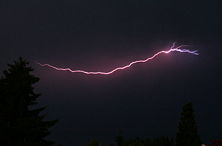
Lightning discharges may occur between areas of cloud having different potentials without contacting the ground. These are most common between the anvil and lower reaches of a given thunderstorm. This lightning can sometimes be observed at great distances at night as so-called "heat lightning." In such instances, the observer may see only a flash of light without thunder. The "heat" portion of the term is a folk association between locally-experienced warmth and the distant lightning flashes.
Dry lightning
Dry lightning is a folk misnomer in common usage in the United States for thunderstorms which produce no precipitation at the surface. This type of lightning is the most common natural cause of wildland fires.
Rocket lightning
Rocket lightning is a form of cloud discharge, generally horizontal and at cloud base, with a luminous channel appearing to advance through the air with visually resolvable speed, often intermittently.[22] The movement resembles that of a rocket, hence its name. It is also one of the rarest of cloud discharges.
Cloud-to-ground
Cloud-to-ground lightning is a great lightning discharge between a cumulonimbus cloud and the ground initiated by the downward-moving leader stroke. This is the second most common type of lightning, and poses the greatest threat to life and property of all known types.
Bead lightning
Bead lightning is a type of cloud-to-ground lightning which appears to break up into a string of short, bright sections, which last longer than the usual discharge channel. It is fairly rare. Several theories have been proposed to explain it. One is that the observer sees portions of the lightning channel end on, and that these portions appear especially bright. Another is that, in bead lighting, the width of the lightning channel varies; as the lightning channel cools and fades, the wider sections cool more slowly and remain visible longer, appearing as a string of beads. [23] [24]
Ribbon lightning
Ribbon lightning occurs in thunderstorms with high cross winds and multiple return strokes. The wind will blow each successive return stroke slightly to one side of the previous return stroke, causing a ribbon effect.
Staccato lightning
Staccato lightning, which is nothing more than a leader stroke with only one return stroke.
Positive lightning
Positive lightning, also known colloquially as a "bolt from the blue," makes up less than 5 percent of all lightning.[25] It occurs when the leader forms at the positively charged cloud tops, with the consequence that a negatively charged streamer issues from the ground. The overall effect is a discharge of positive charges to the ground. Research carried out after the discovery of positive lightning in the 1970s showed that positive lightning bolts are typically six to ten times more powerful than negative bolts, last around ten times longer, and can strike tens of kilometers/miles from the clouds. The voltage difference for positive lightning must be considerably higher, due to the tens of thousands of additional metres/feet the strike must travel. During a positive lightning strike, huge quantities of ELF and VLF radio waves are generated.[26]
As a result of their greater power, positive lightning strikes are considerably more dangerous. At the present time, aircraft are not designed to withstand such strikes, since their existence was unknown at the time standards were set, and the dangers unappreciated until the destruction of a glider in 1999.[27] Positive lightning is also now believed to have been responsible for the 1963 in-flight explosion and subsequent crash of Pan Am Flight 214, a Boeing 707. Subsequently, aircraft operating in U.S. airspace have been required to have lightning discharge wicks to reduce the chances of a similar occurrence.
Positive lightning has also been shown to trigger the occurrence of upper atmosphere lightning. It tends to occur more frequently in winter storms and at the end of a thunderstorm.[28]
An average bolt of positive lightning carries a current of up to 300 kA (kiloamperes) (about ten times as much current as a bolt of negative lightning), transfers a charge of up to 300 coulombs, has a potential difference up to 1 GV (gigavolts), and lasts for hundreds of milliseconds, with a discharge energy of up to 300 GJ (gigajoules).
Anvil-to-ground
One special type of cloud-to-ground lightning is anvil-to-ground lightning. It is a form of positive lightning, since it emanates from the anvil top of a cumulonimbus cloud where the ice crystals are positively charged. The leader stroke issues forth in a nearly horizontal direction until it veers toward the ground. These usually occur miles from (often ahead) of the main storm and will sometimes strike without warning on a sunny day. An anvil-to-ground lightning bolt is a sign of an approaching storm, and if one occurs in a largely clear sky, it is known colloquially as a "Bolt from the blue"[29].
Ground-to-cloud lightning
Ground-to-cloud lightning is a lightning discharge between the ground and a cumulonimbus cloud from an upward-moving leader stroke.
Ball lightning
Ball lightning is described as a floating, illuminated ball that occurs during thunderstorms. They can be fast moving, slow moving, or nearly stationary. Some make hissing or crackling noises or no noise at all. Some have been known to pass through windows and even dissipate with a bang. Ball lightning has been described by eyewitnesses but rarely recorded by meteorologists.
The engineer Nikola Tesla wrote, "I have succeeded in determining the mode of their formation and producing them artificially".[30] There is some speculation that electrical breakdown and arcing of cotton and gutta-percha wire insulation used by Tesla may have been a contributing factor, since some theories of ball lightning require the involvement of carbonaceous materials. Some later experimenters have been able to briefly produce small luminous balls by igniting carbon-containing materials atop sparking Tesla Coils.
Several theories have been advanced to describe ball lightning, with none being universally accepted. Any complete theory of ball lightning must be able to describe the wide range of reported properties, such as those described in Singer's book The Nature of Ball Lightning and also more contemporary research. Japanese research shows that ball lightning has been seen several times without any connection to stormy weather or lightning.
Ball lightning is typically 20 – 30 cm (8-12 inches) in diameter, but ball lightning several meters in diameter has been reported.[31] Ball lightning has been seen in tornadoes, and it has been seen to split apart into two or more separate balls and recombine. Also, vertically linked fireballs have been reported. Because of its strange behavior, ball lightning has been mistaken for a UFO by many witnesses. One theory that may account for this wider spectrum of observational evidence is the idea of combustion inside the low-velocity region of axisymmetric (spherical) vortex breakdown of a natural vortex.[32]
Upper-atmospheric
Reports by scientists of strange lightning phenomena above storms date back to at least 1886. However, it is only in recent years that fuller investigations have been made. This has sometimes been called megalightning.
Sprites
Sprites are now well-documented electrical discharges that occur high above some types of thunderstorms. They appear as luminous reddish-orange, plasma-like flashes, last longer than normal lower stratospheric discharges (typically around 17 milliseconds), and are triggered by the discharges of positive lightning between the thundercloud and the ground. Sprites often occur in clusters of two or more, and typically span the distance from 50 to 90 km (30 to 55 miles) above the earth, with what appear to be tendrils hanging below and branches reaching above. A 2007 paper reports that the apparent tendrils and branches of sprites are actually formed by bright streamer heads of less than 140 m diameter moving up or down at 1 to 10 percent of the speed of light.[33]
Sprites may be horizontally displaced by up to 50 km (30 miles) from the location of the underlying lightning strike, with a time delay following the lightning that is typically a few milliseconds, but on rare occasions may be up to 100 milliseconds. Sprites are sometimes, but not always, preceded by a sprite halo, a broad, pancake-like region of transient optical emission centered at an altitude of about 75 km above lightning. Sprite halos are produced by weak ionization from transient electric fields of the same type that causes sprites, but which are insufficiently intense to exceed the threshold needed for sprites. Sprites were first photographed on July 6, 1989, by scientists from the University of Minnesota and named after the mischievous sprite (air spirit) Ariel in Shakespeare's "The Tempest."
Recent research carried out at the University of Houston in 2002 indicates that some normal (negative) lightning discharges produce a sprite halo, the precursor of a sprite, and that every lightning bolt between cloud and ground attempts to produce a sprite or a sprite halo. Research in 2004 by scientists from Tohoku University found that very low frequency emissions occur at the same time as the sprite, indicating that a discharge within the cloud may generate the sprites.[34]
Blue jets
Blue jets differ from sprites in that they project from the top of the cumulonimbus above a thunderstorm, typically in a narrow cone, to the lowest levels of the ionosphere 40 to 50 km (25 to 30 miles) above the earth. They are also brighter than sprites and, as implied by their name, are blue in color. They were first recorded on October 21, 1989, on a video taken from the Space Shuttle as it passed over Australia. They were subsequently extensively documented in 1994 during aircraft research flights by the University of Alaska.
On September 14, 2001, scientists at the Arecibo Observatory photographed a huge jet double the height of those previously observed, reaching around 80 km (50 miles) into the atmosphere. The jet was located above a thunderstorm over the ocean, and lasted under a second. Lightning was initially observed traveling up at around 50,000 m/s in a similar way to a typical blue jet, but then divided in two and sped at 250,000 m/s to the ionosphere, where they spread out in a bright burst of light. On 22 July 2002, five gigantic jets between 60 and 70 km (35 to 45 miles) in length were observed over the South China Sea from Taiwan, reported in Nature.[35] The jets lasted under a second, with shapes likened by the researchers to giant trees and carrots.
Elves
Elves often appear as a dim, flattened, expanding glow around 400 km (250 miles) in diameter that lasts for, typically, just one millisecond. They occur in the ionosphere 100 km (60 miles) above the ground over thunderstorms. Their color was a puzzle for some time, but is now believed to be a red hue. Elves were first recorded on another shuttle mission, this time recorded off French Guiana on October 7, 1990. Elves is a frivolous acronym for Emissions of Light and Very Low Frequency Perturbations From Electromagnetic Pulse Sources. This refers to the process by which the light is generated; the excitation of nitrogen molecules due to electron collisions (the electrons possibly having been energized by the electromagnetic pulse caused by a discharge from the Ionosphere).
Triggered lightning
Rocket-triggered
Lightning has been triggered directly by human activity in several instances. Lightning struck the Apollo 12 soon after takeoff, and has struck soon after thermonuclear explosions [36]. It has also been triggered by launching lightning rockets carrying spools of wire into thunderstorms. The wire unwinds as the rocket climbs, making a convenient path for the lightning to use. These bolts are typically very straight, due to the path created by the wire.[37]
Volcano-triggered
Extremely large volcanic eruptions, which eject gases and solid material high into the atmosphere, can trigger lightning. This phenomenon was documented by Pliny The Elder during the 79 C.E. eruption of Mount Vesuvius, in which he perished.[38]
Laser-triggered
Since at least the 1970s, researchers have attempted to trigger lightning strikes by means of ultra-violet lasers, which create a channel of ionized gas through which the lightning would be conducted to ground. Such triggered lightning is intended to protect rocket launching pads, electric power facilities, and other sensitive targets. [39] [40] [41] [42] [43] [44]
Extraterrestrial lightning
Lightning requires the electrical breakdown of a gas, so it cannot exist in a visual form in the vacuum of space. However, lightning-like phenomena have been observed within the atmospheres of other planets, such as Venus and Jupiter. Lightning on Venus is still a controversial subject after decades of study. The Soviet Venera and U.S. Pioneer missions of the 1970s and 1980s sent signals suggesting lightning in the upper atmosphere of Venus. More recently, however, the Cassini-Huygens mission fly-by of Venus detected no signs of lightning at all.
Trees and lightning
Trees are frequent conductors of lightning to the ground.[45] Since sap is a poor conductor, its electrical resistance causes it to be heated explosively into steam, which blows off the bark outside the lightning's path. In following seasons trees overgrow the damaged area and may cover it completely, leaving only a vertical scar. If the damage is severe, the tree may not be able to recover, and decay sets in, eventually killing the tree. Occasionally, a tree may explode completely.[46] It is commonly thought that a tree standing alone is more frequently struck, though in some forested areas, lightning scars can be seen on almost every tree.
One type of tree that is frequently struck is the pine. Unlike the oak, which has a relatively shallow root structure,[47] the pine has a deep central root that goes down into the water table. The pine usually stands taller than other species, which also makes it a likely target. In Johannesburg—one place with a very high incidence of lightning strikes—the most commonly struck tree is Cedrus deodara, locally known as the Christmas tree. Factors which lead to its being targeted are a high resin content, its loftiness and its needles which lend themselves to a high electrical discharge during a thunderstorm.
Trees are natural lightning conductors and are known to provide protection against lightning damages to the nearby buildings. Tall trees with high biomass for the root system provide good lightning protection. An example is the teak tree (Tectona grandis), which grows to a height of 45 m. It has a spread root system with a spread of 5 m and a biomass of 4 times that of the trunk; its penetration into the soil is 1.25 m and has no tap root. When planted near a building, its height helps in catching the oncoming lightning leader and the high biomass of the root system helps in dissipation of the lightning charges[48]
Lightning currents are characterized by a high rate of change, on the order of 40 kA per microsecond. Hence, conductors of such currents exhibit marked skin effect, causing most of the currents to flow through the conductor skin.[49] The effective resistance of the conductor is consequently very high and therefore, the conductor skin gets heated up much more than the conductor core. When a tree acts as a natural lightning conductor, due to skin effect most of the lightning currents flow through the skin of the tree and the sap wood. As a result, the skin gets burnt and may even peel off. The moisture in the skin and the sap wood evaporates instantaneously and may get split. If the tree struck by lightning is a teak tree (single stemmed, with branches) it may not be completely destroyed, because only the tree skin and a branch may be affected; the major parts of the tree may be saved from complete destruction due to lightning currents. But if the tree involved is a coconut tree, it may be completely destroyed by the lightning currents.
Records and locations
On average, lightning strikes the earth about 100 times every second. "Lightning Alley," referring to Interstate 4 between Orlando and St. Petersburg, Florida, collectively sees more lightning strikes per year than any other place in the United States. Lightning Alley averages 120 thunderstorm days per year. The Empire State Building is struck by lightning on average 23 times each year, and was once struck 8 times in 24 minutes.[50]
Singapore has one of the highest rates of lightning activity in the world.[51] The city of Teresina in northern Brazil has the third-highest rate of occurrences of lightning strikes in the world. The surrounding region is referred to as the Chapada do Corisco ("Flash Lightning Flatlands").
Roy Sullivan held a Guinness World Record after surviving seven different lightning strikes across 35 years. [52]
In July 2007, lightning killed up to 30 people when it struck a remote mountain village Ushari Dara in northwestern Pakistan. [53] Also, in Deerfield Beach, Florida lightning struck a diver's air tank as he surfaced off Florida's Atlantic coast, killing him. He had surfaced about 30 feet from the boat when lightning struck his tank.
Lightning detection
Lightning discharges generate a wide range of electromagnetic radiations, including radio-frequency pulses. The times at which a pulse from a given lightning discharge arrive at several receivers can be used to locate the source of the discharge. The United States federal government has constructed a nation-wide grid of such lightning detectors, allowing lightning discharges to be tracked in real time throughout the continental U.S. [54] [55]
In addition to ground-based lightning detection, several instruments aboard satellites have been constructed to observe lightning distribution. These include the Optical Transient Detector (OTD) and the subsequent Lightning Imaging Sensor (LIS). [56]
In culture
Culturally, there are various expressions in which lightning is a metaphor for sudden, unusual occurrences. For example, "a bolt from the blue" refers to a totally unexpected event. The expression "lightning never strikes twice [in the same place]" refers to a highly improbable event. It is similar to the expressions "opportunity never knocks twice," or "a once in a lifetime opportunity." Various factors affect the probability of lightning strikes at any given location. Therefore, although lightning does occur frequently in specific areas, there is a low (but not zero) probability for repeat strikes at exactly the same location. [50] [57]
In French and Italian, the expression for "love at first sight" is coup de foudre and colpo di fulmine, respectively, which literally translated mean "bolt of lightning." Some European languages have a separate word for lightning that strikes the ground, as opposed to lightning in general—often it is a cognate of the English word "rays."
The bolt of lightning in heraldry is called a thunderbolt and is shown as a zigzag with non-pointed ends. It is distinguished from the "fork of lightning."
Harry Potter, protagonist in the Harry Potter series of books authored by J.K. Rowling, has a lightning-bolt shaped scar on his forehead. The scar was a result of a failed killing curse, which resulted in the downfall of Lord Voldemort. The scar plays an important role in the series.
See also
Notes
- ↑ 1.0 1.1 1.2 Joseph Needham. 1986. Science and Civilisation in China, Volume 3: Mathematics and the Sciences of the Heavens and the Earth. (Taipei: Caves Books Ltd. ISBN 0521058015).
- ↑ Joseph Needham. 1986. Science and Civilization in China: Volume 5, Chemistry and Chemical Technology, Part 7, Military Technology; the Gunpowder Epic. (Taipei: Caves Books Ltd. ISBN 052132727X)
- ↑ E. Philip Krider, 2004. Benjamin Franklin and the First Lightning Conductors. Proceedings of International Commission on History of Meteorology 1(1):1-13.
- ↑ Tom Tucker. 2003. Bolt of Fate: Benjamin Franklin and His Electric Kite Hoax. (New York, NY: Public Affairs. ISBN 1586482947).
- ↑ Lightning Can Kill Before Storm Strikes.Kansas State Research and News. 2003. Retrieved August 23, 2007.
- ↑ How Hot Is Lightning? Retrieved August 23, 2007.
- ↑ Flashes in the Sky: Lightning Zaps Space Radiation Surrounding Earth. Retrieved August 23, 2007.
- ↑ Robert Roy Britt, 1999. Lightning Interacts with Space, Electrons Rain Down. Retrieved August 23, 2007.
- ↑ M.K. Demirkol, S. Inan Umran, T.F. Bell; S.G. Kanekal; and D.C. Wilkinson. 1999. "Ionospheric effects of relativistic electron enhancement events." Geophysical Research Letters 26(23):3557-3560. (Abstract available on-line at: Smithsonian/NASA ADS Astronomy Abstract Service. Retrieved August 23, 2007.)
- ↑ How Lightning Forms. PBS.org. Retrieved August 23, 2007.
- ↑ 11.0 11.1 Lightning Science. NOAA. Retrieved August 23, 2007.
- ↑ USGS, Hawaii Observation. Account of ash lightning. See 5th paragraph. Retrieved August 23, 2007.
- ↑ Teachers Guide to Stratovolcanoes of the World, Galgunggung, Indonesia. Retrieved August 23, 2007.
- ↑ Electric Ice. NASA. Retrieved August 23, 2007.
- ↑ Alicia Frazier, 2005. THEORIES OF LIGHTNING FORMATION. Department of Atmospheric and Oceanic Sciences, University of Colorado, Boulder. Retrieved August 23, 2007.
- ↑ See Uman. 1986. chapter 12, pages 103-110
- ↑ Gurevich. 2003. How Lightning Works Is Still A Mystery. The Economist.
- ↑ Joseph R. Dwyer, 2005. "A bolt out of the blue." Scientific American 292(5):64-71.
- ↑ Mark Shrope, 2004. Lightning research: The bolt catchers. Nature 431:120-121. Retrieved August 23, 2007.
- ↑ U.S. Inan, S.C. Reising, G.J. Fishman, and J.M. Horack. 1996. On the association of terrestrial gamma-ray bursts with lightning and implications for sprites. Geophysical Research Letters 23(9):1017-1020. As quoted by Red Sprites and Blue Jets. Retrieved August 23, 2007.
- ↑ 21.0 21.1 Uman, 1986, Chapter 5, 41.
- ↑ Definition of Rocket Lightning, AMS Glossary of Meteorology. Retrieved August 23, 2007.
- ↑ Beaded Lightning. American Meteorological Society (AMS). Retrieved August 23, 2007.
- ↑ Uman, 1986, Chapter 16, 139-143.
- ↑ The Positive and Negative Side of Lightning. NOAA. Retrieved August 23, 2007.
- ↑ D. J. Boccippio, et al. 1995. Sprites, ELF Transients, and Positive Ground Strokes. Science 269:1088-1091.
- ↑ Air Accidents Investigation Branch (AAIB) Bulletins 1999 December: Schleicher ASK 21 two seat glider. Retrieved August 23, 2007.
- ↑ A Lightning Primer from the GHCC: Types of Lightning Discharges. Retrieved August 23, 2007.
- ↑ David Lawrence, Bolt from the Blue. National Oceanic and Atmospheric Administration. Retrieved August 23, 2007.
- ↑ Nicola Tesla. 1904. Electrical World and Engineer. Retrieved August 23, 2007.
- ↑ (Singer)
- ↑ Coleman was the first to propose this theory in 1993 in Weather, a publication of the Royal Meteorological Society.
- ↑ H. C. Stenbaek-Nielsen, M.G. McHarg, T. Kanmae, D.D. Sentman. 2007. "Observed emission rates in sprite streamer heads." Geophys. Res. Lett. 34:11. The abstract is publicly accessible. This paper is discussed on LiveScience. Retrieved August 23, 2007.
- ↑ VLF/ELF sferic evidence for in-cloud discharge activity producing sprites. Retrieved August 23, 2007.
- ↑ Letters to nature. Retrieved August 23, 2007.
- ↑ 1987. An empirical study of the nuclear explosion-induced lightning seen on IVY-MIKE. Journal of Geophysical Research 92:D5:5696-5712. Retrieved August 23, 2007.
- ↑ July 25, 2002, triggered lightning video. Retrieved August 23, 2007.
- ↑ Pliney the Younger. Pliny the Younger's Observations. "Behind us were frightening dark clouds, rent by lightning twisted and hurled, opening to reveal huge figures of flame." Retrieved August 23, 2007.
- ↑ 2001. UNM researchers use lasers to guide lightning. Campus News, The University of New Mexico. Retrieved August 23, 2007.
- ↑ Laser-triggered lightning discharge. New Journal of Physics. Retrieved August 23, 2007.
- ↑ Laboratory tests of laser-induced lightning discharge. Journal of Optical Technology. Retrieved August 23, 2007.
- ↑ Applied Physics Letters—December 6, 2004—Volume 85, Issue 23, pp. 5781-5783. Retrieved August 23, 2007.
- ↑ The electric field changes and UHF radiations caused by the lightning in Japan. Retrieved August 23, 2007.
- ↑ A laser-induced lightning concept experiment. Retrieved August 23, 2007.
- ↑ photo of a tree being struck by lightning. Retrieved August 23, 2007.
- ↑ A 120 years old tree exploded by lightning. Arobretum de Villardebelle. Retrieved August 23, 2007.
- ↑ Oak Root Research. Olympia Forestry Sciences Laboratory. Retrieved August 23, 2007.
- ↑ Gopalan. 2005. Lightning protection of airport runway. ASCE Jl of Performance of Constructed Facilities 19:4.
- ↑ Zinnia Nair, et al. May 1, 2005. Failure of 220 kV double circuit transmission line tower due to lightning. ASCE Jl of Performance of Constructed Facilities 19 (2).
- ↑ 50.0 50.1 Uman, 1986, chapter 6, 47.
- ↑ Lightning Activity in Singapore. National Environmental Agency. Retrieved August 23, 2007.
- ↑ SULLIVAN, Roy. The New York Times Archives (from UPI). Retrieved August 23, 2007.
- ↑ Lightning kills 30 people in Pakistan's north. Reuters. Retrieved August 23, 2007.
- ↑ Lightning Detection Systems. NOAA page on how the U.S. national lightning detection system operates. Retrieved August 23, 2007.
- ↑ Vaisala Thunderstorm Online Application Portal. Real-time map of lightning discharges in U.S. Retrieved August 23, 2007.
- ↑ Dataset Information LIS browse images OTD browse images. Retrieved August 23, 2007.
- ↑ Jesus actor struck by lightning.BBC News October 23, 2003. Retrieved August 23, 2007.
ReferencesISBN links support NWE through referral fees
- Anders, André. 2003. Tracking Down the Origin of Arc Plasma Science I. Early Pulsed and Oscillating Discharges. IEEE Transactions on Plasma Science 31(4):1052-1059.
- Dwyer, Joseph R. 2005. A Bolt out of the Blue. Scientific American. Retrieved August 23, 2007.
- Giella, Thomas F. My Very Close Encounters With Florida Lightning Bolts. Retrieved August 23, 2007.
- Gosline, Anna. 1986. Thunderbolts from space. New Scientist 186(2498):30-34.
- Larsen, Alex. 1905. Photographing Lightning With a Moving Camera. Annual Report Smithsonian Institute 60(1):119-127.
- Rakov, V.A. and Martin A. Uman. 2003. Lightning, physics and effects. Cambridge, UK: Cambridge University Press. ISBN 0521583276.
- Uman, Martin. 1986. All About Lightning. Mineola, NY: Dover Publications, Inc. ISBN 048625237X. (This book is written for the layman.)
- The Mirror of Literature, Amusement, and Instruction, Vol. 12, Issue 323, July 19, 1828 The Project Gutenberg eBook (early lightning research). Retrieved August 23, 2007.
- Krampf, Robert. 1991. Electricity. VHS Video. Memphis, TN: William Bearden Co.
External links
- Central Florida's "Lightning Stalker" photography. Retrieved August 23, 2007.
- How Lightning Works HowStuffWorks. Retrieved August 23, 2007.
- My Very Close Encounters With Florida Lightning Bolts By Thomas F. Giella, KN4LF Retired Meteorologist & Space Plasma Physicist. Retrieved August 23, 2007.
- Positive lightning photography from Florida. Retrieved August 23, 2007.
- Severe Weather UK. Retrieved August 23, 2007.
- Impressive lightning photography More than 200 Lightning-Pictures. Retrieved August 23, 2007.
- Source: German Weather Chronicles. Retrieved August 23, 2007.
- 1.21 Gigawatts! Lightning safety and first-aid in the backcountry. Retrieved August 23, 2007.
- How cosmic rays trigger lightning strikes. Retrieved August 23, 2007.
- dmoz: Thunderstorms and Lightning. Retrieved August 23, 2007.
- Lightning Safety Page - National Weather Service Pueblo Colorado Citat: "…This is known as a "side flash." Many people who are "struck" by lightning are not hit directly by the main lightning channel, but are affected by the side flash…." Retrieved August 23, 2007.
- Lightning Facts. Retrieved August 23, 2007.
- Laser Beam Triggers Lightning Strike During Japanese Experiment. Retrieved August 23, 2007.
- Colorado Lightning Resource Center. Retrieved August 23, 2007.
- Webarchive: April 25, 1997 Sandia-led research may zap old beliefs about lightning protection at critical facilities; Triggered lightning tests leading to safer storage bunkers. Retrieved August 23, 2007.
- 2003-11-06, ScienceDaily: Thunderstorm Research Shocks Conventional Theories; Florida Tech Physicist Throws Open Debate On Lightning's Cause. Retrieved August 23, 2007.
- Huge oak tree destroyed by lightning, by Igor Chudov. Retrieved August 23, 2007.
- Austrian Lightning Detection and Information System. Retrieved August 23, 2007.
- European Cooperation for Lightning Detection. Retrieved August 23, 2007.
- How to Photograph Lightning A page with both brief and verbose instructions on taking lightning photos. Retrieved August 23, 2007.
- Positive Lightning Strike Photo of a nearby positive lightning strike that nearly kills the Australian photographer. Retrieved August 23, 2007.
- Petrified lightning (fulgurites) from Central Florida. Retrieved August 23, 2007.
- United States Precision Lightning Network - Live lightning data map. Retrieved August 23, 2007.
- NASA Finds Lightning Clears Safe Zone in Earth's Radiation Belt. Retrieved August 23, 2007.
- AMS Glossary: Dart Leader
- NOAA: What is Lightning?. Retrieved August 23, 2007.
- Theories of Lightning formation. Retrieved August 23, 2007.
- Lucky snapshot: lightning strikes chemical mill in Germany. Retrieved August 23, 2007.
- Lightning over Luxembourg. Retrieved August 23, 2007.
- Lightning detection system shows lightning activity in the Tampa Bay, Florida area. Retrieved August 23, 2007.
- Lightning Test. Retrieved August 23, 2007.
- National Geographic Lightning Simulator. Retrieved August 23, 2007.
- Live storm data and sferics for southern England generated by data recorded by a weather station at Newport, Isle of Wight, UK. Retrieved August 23, 2007.
Jets, sprites & elves
- Homepage of the Eurosprite campaign, itself part of the CAL (Coupled Atmospheric Layers) research group. eurosprite.net. Retrieved August 23, 2007.
- Ground and Balloon-Borne Observations of Sprites and Jets. Quote: "…Red sprites and blue jets are brief but powerful lightning-like flashes that appear at altitudes of 40-100 km (25-60 miles) above thunderstorms…." Retrieved August 23, 2007.
- Darwin Sprites '97. Space Physics Group, University of Otago. Retrieved August 23, 2007.
- Gibbs, W. Wayt. Sprites and Elves: Lightning's strange cousins flicker faster than light itself. San Francisco. ScientificAmerican.com. Retrieved August 23, 2007.
- Sprites, jets and TLE pictures and articles. spritesandjets.com. Retrieved August 23, 2007.
Credits
New World Encyclopedia writers and editors rewrote and completed the Wikipedia article in accordance with New World Encyclopedia standards. This article abides by terms of the Creative Commons CC-by-sa 3.0 License (CC-by-sa), which may be used and disseminated with proper attribution. Credit is due under the terms of this license that can reference both the New World Encyclopedia contributors and the selfless volunteer contributors of the Wikimedia Foundation. To cite this article click here for a list of acceptable citing formats.The history of earlier contributions by wikipedians is accessible to researchers here:
The history of this article since it was imported to New World Encyclopedia:
Note: Some restrictions may apply to use of individual images which are separately licensed.

